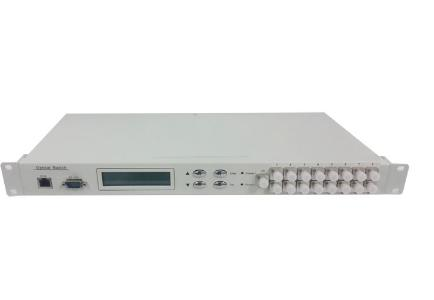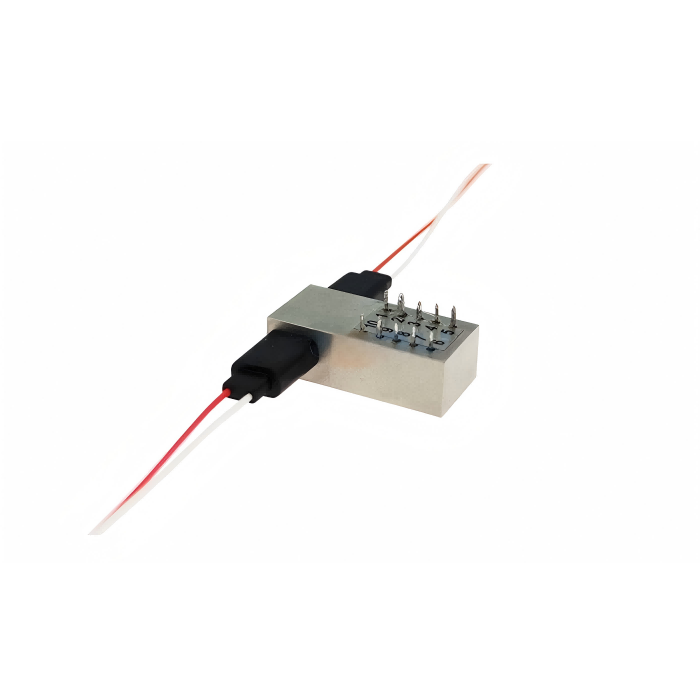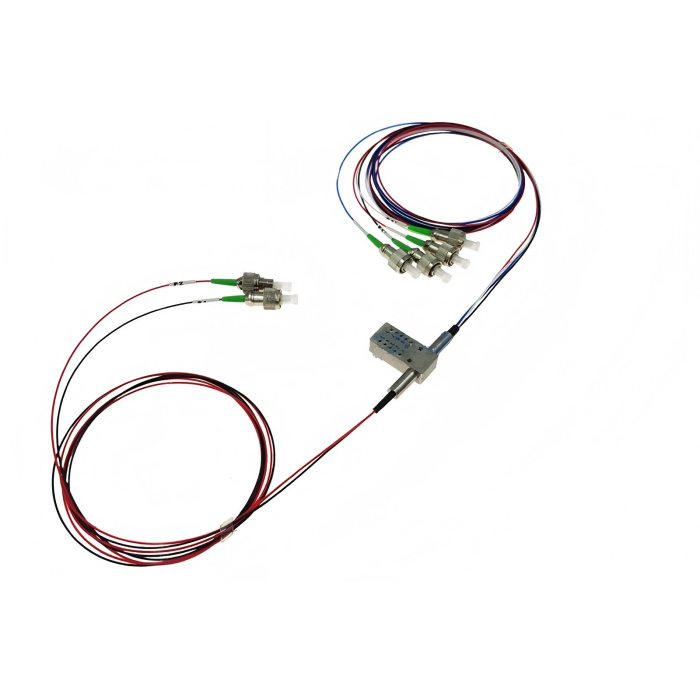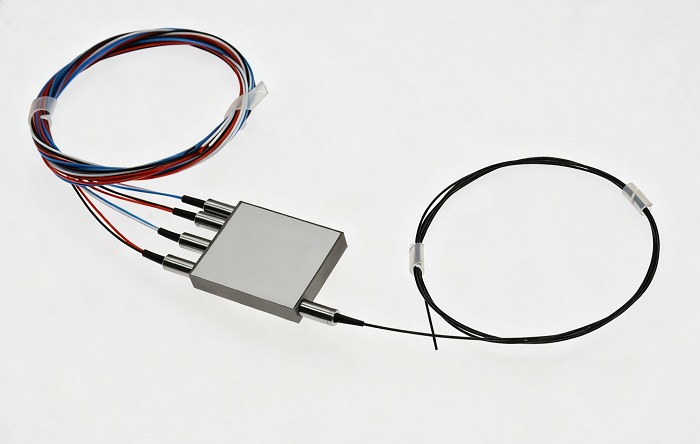FSW-1U-1X10-MM-FCPC
The FSW-1U-1X10-MM-FCPC is a high‑performance optical path control device designed for reliable signal routing in rack‑based communication systems. It features low insertion loss (≤1.2 dB), fast switching time (≤10 ms), and high channel isolation (≥35 dB), ensuring stable operation across the 850 nm wavelength range. Equipped with an intuitive LCD display and supporting both manual control and programmable operation via RS‑232 or Ethernet interfaces, this switch is ideal for multi‑channel optical monitoring, LAN source/detector switching, and optical test systems. Housed in a standard 19‑inch 1U chassis, it offers flexible integration for data centers, labs, and industrial applications.
Description
Product Overview
Product Features
Technical Specifications
| Model | FSW-1U-1X10-MM-FCPC |
|---|---|
| Operating Wavelength | 850nm |
| Test Wavelength | 850nm |
| Insertion Loss | ≤1.2dB |
| Repeatability | ≤±0.02dB |
| Return Loss | ≥30dB |
| Crosstalk | ≥35dB |
| Polarization-Dependent Loss (PDL) | ≤0.05dB |
| Switching Time | ≤10ms (adjacent sequential switching) |
| Fiber Type | MM (50/125μm) |
| Connector Type | FC/PC |
| Monitoring Ports | RJ45, RS-232 |
| Operating Power Supply | Single AC: 85~264V (50/60Hz) |
| Operating Temperature | -5~+60℃ |
| Storage Temperature | -40~+80℃ |
| Chassis Type | 19-inch standard 1U rack (483×200×44mm) |

Program-Controlled Commands
(1) The instrument executes only one command at a time. Wait for the program to return a response before entering the next command.
(2) Use uppercase letters for commands.
(3) In actual operation, use “<” as the start character and “>” as the end character.
Programmed Instruction Set
| Command | Description | Example |
|---|---|---|
| <ADXX_S_YY>
Note: Stops automatic scanning |
Set current channel (for <100 channels):
– XX: 00~99 (device address) – YY: 00~99 (target channel) Success return: <ADXX_OK> Failure return: <ADXX_E1> or <ADXX_E2> |
<AD01_S_09> (optical switch with address 01 switches to channel 09).
– Success return (if >9 channels): <AD01_OK> – Failure return (if <9 channels): <AD01_E1> |
| <ADXX_S_YYY>
Note: Stops automatic scanning |
Set current channel:
– XX: 00~99 (device address) – YYY: 000~128 (target channel) Success return: <ADXX_OK> Failure return: <ADXX_E1> or <ADXX_E2> |
<AD01_S_064> (optical switch with address 01 switches to channel 064).
– Success return (if >64 channels): <AD01_OK> – Failure return (if <64 channels): <AD01_E1> |
| <ADXX_C_YY>
Note: Stops automatic scanning |
Set current channel (for <100 channels):
– XX: 00~99 (device address) – YY: 00~99 (target channel) No return value! Use with caution to avoid misoperation. |
<AD01_C_09> (optical switch with address 01 switches to channel 09).
No return information. |
| <ADXX_C_YYY>
Note: Stops automatic scanning |
Set current channel:
– XX: 00~99 (device address) – YYY: 000~128 (target channel) No return value! Use with caution to avoid misoperation. |
<AD01_C_064> (optical switch with address 01 switches to channel 064).
No return information. |
| <ADXX_B_YYY_E_ZZZ> | Set automatic scanning channels:
– XX: 00~99 (device address) – YYY: 001~128 (start channel) – ZZZ: 001~128 (end channel) Success return: <ADXX_OK> Failure return: <ADXX_E1> or <ADXX_E2> |
<AD01_B_001_E_008> (scans channels 1→2→…→8→1).
<AD01_B_008_E_002> (scans channels 8→…→2→8). |
| <ADXX_B_E_?> | Query automatic scanning channels:
Return: <ADXX_YYY_ZZZ> – XX: 00~99 (device address) – YYY: 001~128 (start channel) – ZZZ: 001~128 (end channel) |
<AD01_B_E_?> (returns <AD01_004_008>, meaning start channel 004, end channel 008). |
| <ADXX_T_CHN?>
Note: Stops automatic scanning |
Query current channel:
– Return <ADXX_YY> (for <100 channels): XX=00~99 (address), YY=00~99 (current channel) – Return <ADXX_YYY> (for ≥100 channels): XX=00~99 (address), YYY=000~128 (current channel) |
<AD01_T_CHN?> (if current channel=2:
– <100 channels: returns <AD01_02> – ≥100 channels: returns <AD01_002>). |
| <ADXX_M_STA?>
Note: Stops automatic scanning |
Query optical switch status:
– Return <ADXX_OK> (normal operation) – Return <ADXX_E1> (data overflow) – Return <ADXX_E2> (operation error) |
<AD01_M_STA?> (normal: returns <AD01_OK>; error: returns <AD01_E2>). |
| <ADXX_A_YY> | Set automatic scanning interval and start:
– XX: 00~99 (device address) – YY: 00~99 (interval = YY×100ms; default 100ms if YY=00) Success return: <ADXX_YY> (current channel, lists scanned channels). |
<AD01_A_10> (interval=1000ms; if current channel=2:
– <100 channels: returns <AD01_02>→<AD01_03>… – ≥100 channels: returns <AD01_002>→<AD01_003>…). |
| <ADXX_F_YY> | Set automatic scanning interval and start:
– XX: 00~99 (device address) – YY: 00~99 (interval = YY×100ms; default 100ms if YY=00) Success return: <ADXX_OK> (no scanned channels listed). |
<AD01_F_10> (success return <AD01_OK>; switches every 1000ms, no return info). |
| <ADXX_A_T_HH_MM_SS>
Note: Stops scanning if “HH_MM_SS”= “00_00_00” |
Set automatic scanning interval (HH:MM:SS) and start:
– XX: 00~99 (address) – HH:00~99 (hours), MM:00~59 (minutes), SS:00~59 (seconds) Success return: <ADXX_YY> (current channel, lists scanned channels). Stops scanning and returns <ADXX_OK> if HH_MM_SS=00_00_00. |
<AD01_A_T_01_02_30> (switches every 1h2min30s; if current channel=2:
– <100 channels: returns <AD01_02>→<AD01_03>… – ≥100 channels: returns <AD01_002>→<AD01_003>…). |
| <ADXX_F_T_HH_MM_SS>
Note: Stops scanning if “HH_MM_SS”= “00_00_00” |
Set automatic scanning interval (HH:MM:SS) and start:
– XX: 00~99 (address) – HH:00~99 (hours), MM:00~59 (minutes), SS:00~59 (seconds) Success return: <ADXX_OK> (no scanned channels listed). Stops scanning if HH_MM_SS=00_00_00. |
<AD01_F_T_01_02_30> (success return <AD01_OK>; switches every 1h2min30s, no return info). |
| <ADXX_U_VALUE> | Set serial port baud rate:
– XX: 00~99 (current device address) – VALUE: 1200/2400/4800/9600/19200/57600 Success return: <ADXX_OK> |
<AD01_U_9600> (sets baud rate to 9600).
<AD01_U_19200> (sets baud rate to 19200). |
| <ADXX_KEY_Y> | Set/query key permission:
– XX: 00~99 (current address) – Y=0 (disable), Y=1 (enable): return <ADXX_OK> – Y=? (query): return <ADXX_KEY_0> or <ADXX_KEY_1> |
<AD01_KEY_1> (keys enabled).
<AD01_KEY_0> (keys disabled). <AD01_KEY_?> (returns <AD01_KEY_1> if enabled, <AD01_KEY_0> if disabled). |
| <ADXX_LOCK_Y> | Set/query panel channel switching permission:
– XX: 00~99 (current address) – Y=1 (lock), Y=0 (allow): return <ADXX_OK> – Y=? (query): return <ADXX_LOCK_0> or <ADXX_LOCK_1> |
<AD01_LOCK_1> (switching locked).
<AD01_LOCK_0> (switching allowed). <AD01_LOCK_?> (returns <AD01_LOCK_1> if locked, <AD01_LOCK_0> if allowed). |
| <ADXX_G_YY> | Change device address:
– XX: 00~99 (current address) – YY: 00~99 (new address) Success return: <ADYY_OK> |
<AD01_G_03> (changes address to 03; returns <AD03_OK>). |
| <ADXX_MAX_?> | Query total channels:
– XX: 00~99 (current address) Success return: <ADYY_MAX_024> (example for 24 channels) |
<AD01_MAX_?> (returns <AD01_MAX_024>, meaning 24 total channels). |




